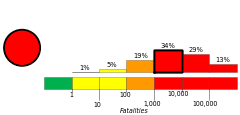M 7.8 - 67 km NNE of Bharatpur, Nepal
- 2015-04-25 06:11:25 (UTC)
- 28.231°N 84.731°E
- 8.2 km depth
Interactive Map Regional Information Felt Report - Tell Us! 001131Responses Contribute to citizen science. Please tell us about your experience.
- Did You Feel It?
VIIImmi 
Community Internet Intensity Map - ShakeMap
IXmmi 
Estimated Intensity Map - PAGER
RED 
Estimated Economic Losses 
Estimated Fatalities Ground Failure - Landslide Estimate
Extensive area affected
Extensive population exposed
- Liquefaction Estimate
Extensive area affected
Extensive population exposed
Origin - Review Status
- REVIEWED
- Magnitude
- 7.8 mww
- Depth
- 8.2 km
- Time
- 2015-04-25 06:11:25 UTC
Moment Tensor Fault Plane Solution Finite Fault 
Cross-section of slip distribution. View Nearby Seismicity - Time Range

± Three Weeks - Search Radius

250.0 km - Magnitude Range

≥ 4.0
Contributors US
USGS National Earthquake Information Center, PDE
Tectonic Summary
The April 25, 2015, M 7.8 Nepal earthquake occurred as the result of thrust faulting on or near the main thrust interface between the subducting India plate and the overriding Eurasia plate to the north. At the location of this earthquake, approximately 80 km to the northwest of the Nepalese capital of Kathmandu, the India plate is converging with Eurasia at a rate of 45 mm/yr towards the north-northeast—a fraction of which (about 18 mm/yr) is driving the uplift of the Himalayan Mountain Range. The preliminary location, size and focal mechanism solutions of the April 25th earthquake are consistent with its occurrence on the decollément associated with the Main Himalayan Thrust, which defines the subduction thrust interface between the India and Eurasia plates.
While commonly plotted as points on maps, earthquakes of this size are more appropriately described as slip over a larger fault area. Thrust-faulting events of the size of the April 25, 2015, earthquake are typically about 100x50 km (length x width); early modeling of this earthquake implies dimensions of about 120x80 km, directed from the hypocenter eastward, and towards Kathmandu. As a result, substantial seismic energy was generated by faulting very close to the city.
The boundary region of the India and Eurasia plates has a history of large and great-sized earthquakes. Four events of M 6 or larger have occurred within 250 km of the April 25, 2015, earthquake over the past century. One, a M 6.9 earthquake in August 1988, 240 km to the southeast of the April 25th event, caused close to 1,500 fatalities. The largest, a M 8.0 event known as the 1934 Nepal-Bihar earthquake, ruptured a large section of the fault to the east of this 2015 event, in a similar location to the 1988 earthquake. It severely damaged Kathmandu, and is thought to have caused about 10,600 fatalities. Prior to the 20th century, a large earthquake in 1833 is thought to have ruptured a similar area as the 2015 event.
Hayes et al. (2016) Tectonic summaries of magnitude 7 and greater earthquakes from 2000 to 2015, USGS Open-File Report 2016-1192. (5.2 MB PDF)
Summary Poster


